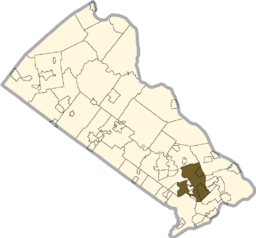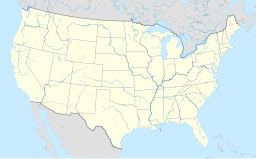Middletown Township, Bucks County, Pennsylvania
| Middletown Township | |
| Settlement | |
| Country | United States |
|---|---|
| State | Pennsylvania |
| County | Bucks County |
| Elevation | 75 ft (22.9 m) |
| Coordinates | 40°09′45″N 74°53′43″W / 40.16250°N 74.89528°WCoordinates: 40°09′45″N 74°53′43″W / 40.16250°N 74.89528°W |
| Area | 19.4 sq mi (50.2 km2) |
| - land | 19.1 sq mi (49 km2) |
| - water | 0.3 sq mi (1 km2), 1.55% |
| Population | 45,436 (2010) |
| Density | 2,309.5/sq mi (891.7/km2) |
| Timezone | EST (UTC-5) |
| - summer (DST) | EDT (UTC-4) |
| Area code | 215 |
|
Location of Middletown Township in Bucks County
|
|
|
Website: www |
|
Middletown Township is a township in Bucks County, Pennsylvania, United States. The population was 45,436 at the 2010 census. Many sections of Levittown, Pennsylvania, are located in the southern end of the township. The municipality surrounds the boroughs of Langhorne, Langhorne Manor, Penndel and Hulmeville; much of the township beyond Levittown uses Langhorne, Pennsylvania as a mailing address.
Also located within the township is Core Creek Park. The township also has many acres of protected woods, the largest being the woods behind Neshaminy High School. The Neshaminy Creek flows through these woods. There are also a few protected farms, significantly that of Styer's Orchards, which was saved from turning into the site of 632 homes in the late 1990s.
Sesame Place is located in Middletown Township.
According to the United States Census Bureau, the township has a total area of 19.4 square miles (50.2 km²), of which, 19.1 square miles (49.5 km²) of it is land and 0.3 square miles (0.7 km²) of it (1.39%) is water.
Middletown Township began as a farming community, with close proximity to trading towns such as Langhorne and Newtown. There are not many significant historical places located in the township apart from homes and farms constructed in the late 18th century.
Middletown Township was sparsely populated before 1950: there were only a little more than 2,000 people in 1930, compared to about 46,000 in 2010. Then William Levitt began his second Levittown, which included land of four municipalities, including that of Middletown. Twelve developments were constructed in the township, with the majority of them containing hundreds of homes. This marked the first planned residential development in the township. Meanwhile, Langhorne Terrace was being constructed out of the Neshaminy Woods. During this decade, the township grow by over 440%, or more than 20,000 new residents. As the decades worn on, hundreds and hundreds of acres of pristine woods, rolling countryside, and productive farms continued to be swallowed into homes and businesses. In the 1970s, the Oxford Valley Mall was constructed, and at the time was named the country's largest mall for a short time. Growth continues to this day; however, Middletown has taken action. The township preserved hundreds of acres now known as Core Creek Park, which includes the sprawling Lake Luxembourg. Many woodlands and a few farms have also been saved. The township has transformed from a bucolic, rural area to a highly desirable and well-planned community, with low crime and an award-winning school district. This is why the township is still seeing a growing population, attracting many out-of-state residents and international migrants. Middletown also benefits from its convenient location. Located in the near center of the county, Middletown is close to almost any other municipality nearby, including the cities of Philadelphia, Trenton, and Princeton. Both I-95 and U.S. 1 pass through the township, offering its residents an easy commute, with the exception of rush hour traffic, which too has been greatly reduced and continues to be in ongoing road projects.
...
Wikipedia




